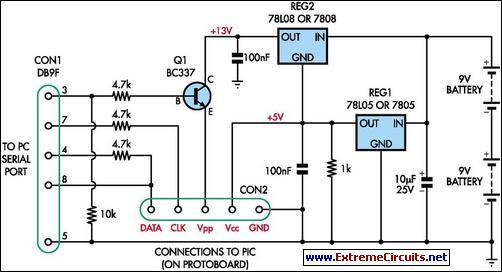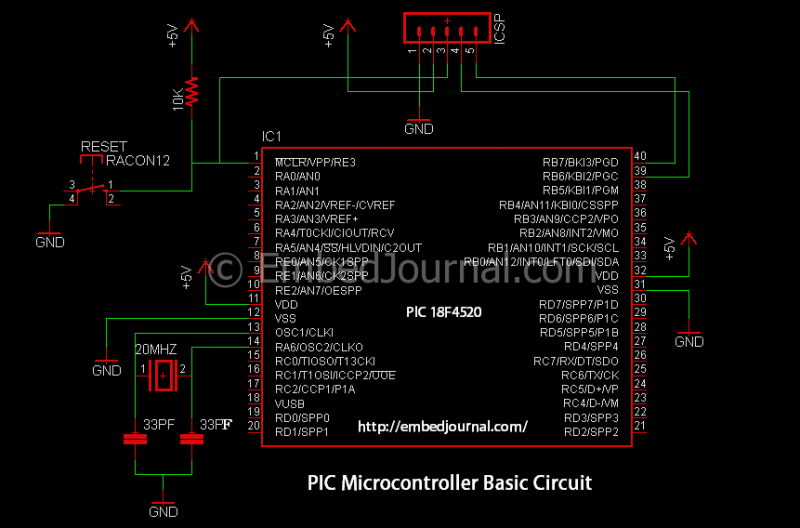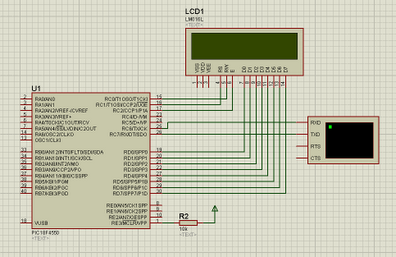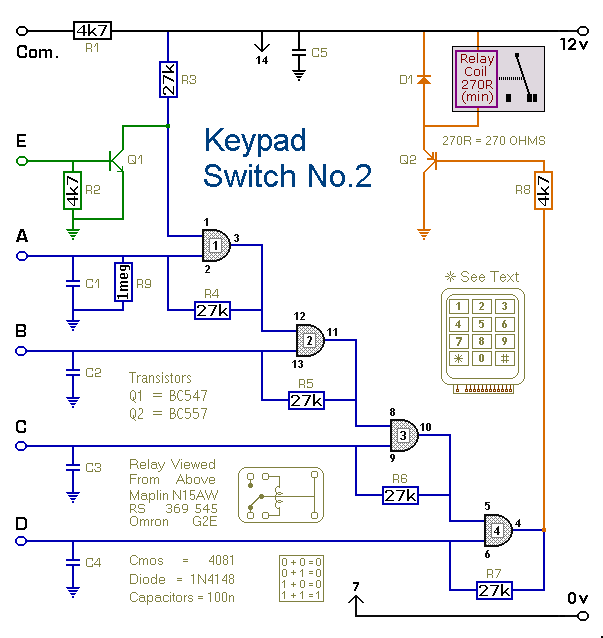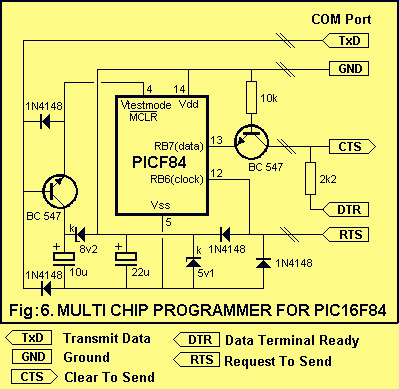
matrix keypad pic mikroc library
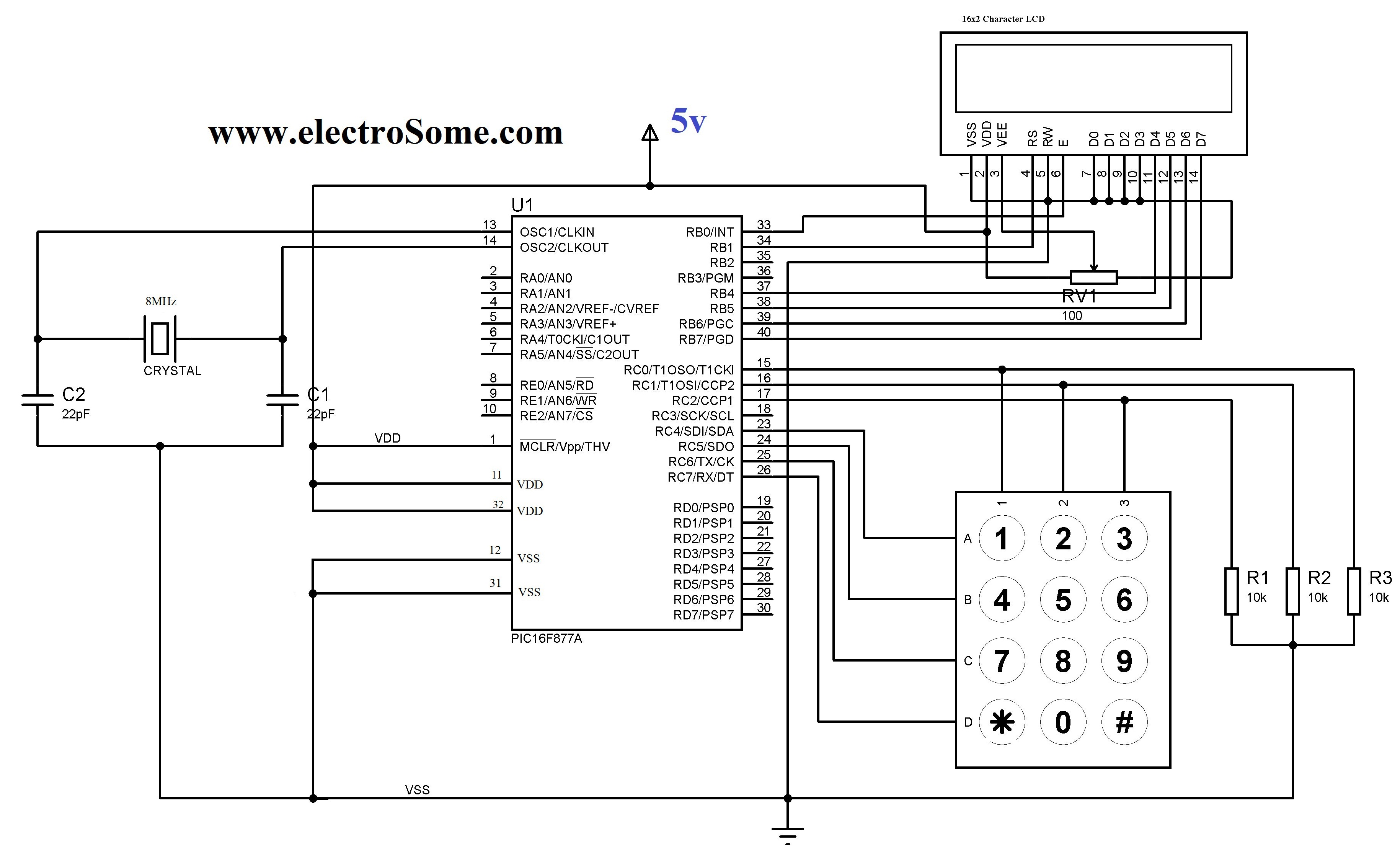
This function initializes a specific port for keypad operation. A global variable for the keypad port must be defined before using this function. The port needs to be initialized prior to calling the function. It reads the key when pressed and returns a number corresponding to the pressed key (1 to 16). If no key is pressed, it returns 0. Upon calling this function, it waits until a key is pressed and released. When released, it returns a number corresponding to the pressed key. If multiple keys are pressed, the function waits until all pressed keys are released and returns the number corresponding to the first pressed key. For demonstration, a 4x3 keypad will be used. The pressed key and the number of times a particular key is pressed are displayed on an LCD.
The keypad module connections are defined with the variable `keypadPort` assigned to `PORTC`. The LCD module connections include several bits set for control and data lines. The main function initializes the keypad and LCD, clears the display, and sets up the output format. A loop continuously waits for a key press, captures the key code, and displays the corresponding ASCII value and count of key presses on the LCD.
The circuit utilizes a 4x3 matrix keypad, which has 12 keys arranged in 4 rows and 3 columns. The keypad is connected to PORTC of a microcontroller, which is responsible for reading the key presses. The LCD is connected to PORTB, and it is used to provide visual feedback to the user regarding the key pressed and the count of how many times that key has been pressed.
In the main function, the keypad initialization is performed first, followed by the LCD initialization. The display is cleared and set to show a message indicating the key being pressed and the count of presses. The program enters an infinite loop where it waits for a key press. Upon detecting a key press, the function captures the key code and converts it to its ASCII equivalent for display on the LCD.
The program checks if the current key press differs from the previous one to determine if it is a new press or a repeated press. If it is a new press, the count is reset; if it is the same key, the count is incremented. The ASCII value of the pressed key and the count of presses are continuously updated on the LCD.
This design demonstrates effective use of both the keypad and LCD in a microcontroller environment, allowing for user interaction through key presses and providing immediate feedback through visual display.It initializes a particular port for working with keypad. A global variable keypad Port must be defined before using this function. Port need to be initialized before calling this function. This function reads key when a key is pressed and it returnsnumber corresponding (1 16) to the pressed key. If no key is pressed, it will return 0. When this function is called, it waits until some key is pressed and released. When released it returns number corresponding (1 16) to the pressed key. If no key is pressed, it will return 0. If more than one key is pressed, the function waits until all pressed keys are released and returns number corresponds to first pressed key. Port need to be initialized before calling this function. Fordemonstrationof the working, here we will use a 4*3 keypad. The pressed key and number of times a particular key is pressed in displayed in LCD Display. unsigned short kp, cnt, oldstate = 0; char txt[6]; // Keypad module connections char keypadPort at PORTC; // End Keypad module connections // LCD module connections sbit LCD_RS at RB1_bit; sbit LCD_EN at RB0_bit; sbit LCD_D4 at RB4_bit; sbit LCD_D5 at RB5_bit; sbit LCD_D6 at RB6_bit; sbit LCD_D7 at RB7_bit; sbit LCD_RS_Direction at TRISB1_bit; sbit LCD_EN_Direction at TRISB0_bit; sbit LCD_D4_Direction at TRISB4_bit; sbit LCD_D5_Direction at TRISB5_bit; sbit LCD_D6_Direction at TRISB6_bit; sbit LCD_D7_Direction at TRISB7_bit; // End LCD module connections void main() { cnt = 0; // Reset counter Keypad_Init(); // Initialize Keypad Lcd_Init(); // Initialize Lcd Lcd_Cmd(_LCD_CLEAR); // Clear display Lcd_Cmd(_LCD_CURSOR_OFF); // Cursor off Lcd_Out(1, 1, "1"); Lcd_Out(1, 1, "Key :"); // Write message text on Lcd Lcd_Out(2, 1, "Times:"); do { kp = 0; // Reset key code variable // Wait for key to be pressed and released do //kp = Keypad_Key_Press(); // Store key code in kp variable kp = Keypad_Key_Click(); // Store key code in kp variable while (!kp); // Prepare value for output, transform key to it`s ASCII value switch (kp) { case 1: kp = 49; break; // 1 case 2: kp = 50; break; // 2 case 3: kp = 51; break; // 3 //case 4: kp = 65; break; // A commented since 4th column is absent for 4*3 keypad case 5: kp = 52; break; // 4 case 6: kp = 53; break; // 5 case 7: kp = 54; break; // 6 //case 8: kp = 66; break; // B commented since 4th column is absent for 4*3 keypad case 9: kp = 55; break; // 7 case 10: kp = 56; break; // 8 case 11: kp = 57; break; // 9 //case 12: kp = 67; break; // C commented since 4th column is absent for 4*3 keypad case 13: kp = 42; break; // * case 14: kp = 48; break; // 0 case 15: kp = 35; break; // # //case 16: kp = 68; break; // D } if (kp != oldstate) { // Pressed key differs from previous cnt = 1; oldstate = kp; } else { // Pressed key is same as previous cnt+; } Lcd_Chr(1, 10, kp); // Print key ASCII value on Lcd if (cnt = 255) { // If counter varialble overflow cnt = 0; Lcd_Out(2, 10, " "); } WordToStr(cnt, txt); // Transform counter value to string Lcd_Out(2, 10, txt); // Display counter value on Lcd } while (1); }
🔗 External reference
The keypad module connections are defined with the variable `keypadPort` assigned to `PORTC`. The LCD module connections include several bits set for control and data lines. The main function initializes the keypad and LCD, clears the display, and sets up the output format. A loop continuously waits for a key press, captures the key code, and displays the corresponding ASCII value and count of key presses on the LCD.
The circuit utilizes a 4x3 matrix keypad, which has 12 keys arranged in 4 rows and 3 columns. The keypad is connected to PORTC of a microcontroller, which is responsible for reading the key presses. The LCD is connected to PORTB, and it is used to provide visual feedback to the user regarding the key pressed and the count of how many times that key has been pressed.
In the main function, the keypad initialization is performed first, followed by the LCD initialization. The display is cleared and set to show a message indicating the key being pressed and the count of presses. The program enters an infinite loop where it waits for a key press. Upon detecting a key press, the function captures the key code and converts it to its ASCII equivalent for display on the LCD.
The program checks if the current key press differs from the previous one to determine if it is a new press or a repeated press. If it is a new press, the count is reset; if it is the same key, the count is incremented. The ASCII value of the pressed key and the count of presses are continuously updated on the LCD.
This design demonstrates effective use of both the keypad and LCD in a microcontroller environment, allowing for user interaction through key presses and providing immediate feedback through visual display.It initializes a particular port for working with keypad. A global variable keypad Port must be defined before using this function. Port need to be initialized before calling this function. This function reads key when a key is pressed and it returnsnumber corresponding (1 16) to the pressed key. If no key is pressed, it will return 0. When this function is called, it waits until some key is pressed and released. When released it returns number corresponding (1 16) to the pressed key. If no key is pressed, it will return 0. If more than one key is pressed, the function waits until all pressed keys are released and returns number corresponds to first pressed key. Port need to be initialized before calling this function. Fordemonstrationof the working, here we will use a 4*3 keypad. The pressed key and number of times a particular key is pressed in displayed in LCD Display. unsigned short kp, cnt, oldstate = 0; char txt[6]; // Keypad module connections char keypadPort at PORTC; // End Keypad module connections // LCD module connections sbit LCD_RS at RB1_bit; sbit LCD_EN at RB0_bit; sbit LCD_D4 at RB4_bit; sbit LCD_D5 at RB5_bit; sbit LCD_D6 at RB6_bit; sbit LCD_D7 at RB7_bit; sbit LCD_RS_Direction at TRISB1_bit; sbit LCD_EN_Direction at TRISB0_bit; sbit LCD_D4_Direction at TRISB4_bit; sbit LCD_D5_Direction at TRISB5_bit; sbit LCD_D6_Direction at TRISB6_bit; sbit LCD_D7_Direction at TRISB7_bit; // End LCD module connections void main() { cnt = 0; // Reset counter Keypad_Init(); // Initialize Keypad Lcd_Init(); // Initialize Lcd Lcd_Cmd(_LCD_CLEAR); // Clear display Lcd_Cmd(_LCD_CURSOR_OFF); // Cursor off Lcd_Out(1, 1, "1"); Lcd_Out(1, 1, "Key :"); // Write message text on Lcd Lcd_Out(2, 1, "Times:"); do { kp = 0; // Reset key code variable // Wait for key to be pressed and released do //kp = Keypad_Key_Press(); // Store key code in kp variable kp = Keypad_Key_Click(); // Store key code in kp variable while (!kp); // Prepare value for output, transform key to it`s ASCII value switch (kp) { case 1: kp = 49; break; // 1 case 2: kp = 50; break; // 2 case 3: kp = 51; break; // 3 //case 4: kp = 65; break; // A commented since 4th column is absent for 4*3 keypad case 5: kp = 52; break; // 4 case 6: kp = 53; break; // 5 case 7: kp = 54; break; // 6 //case 8: kp = 66; break; // B commented since 4th column is absent for 4*3 keypad case 9: kp = 55; break; // 7 case 10: kp = 56; break; // 8 case 11: kp = 57; break; // 9 //case 12: kp = 67; break; // C commented since 4th column is absent for 4*3 keypad case 13: kp = 42; break; // * case 14: kp = 48; break; // 0 case 15: kp = 35; break; // # //case 16: kp = 68; break; // D } if (kp != oldstate) { // Pressed key differs from previous cnt = 1; oldstate = kp; } else { // Pressed key is same as previous cnt+; } Lcd_Chr(1, 10, kp); // Print key ASCII value on Lcd if (cnt = 255) { // If counter varialble overflow cnt = 0; Lcd_Out(2, 10, " "); } WordToStr(cnt, txt); // Transform counter value to string Lcd_Out(2, 10, txt); // Display counter value on Lcd } while (1); }
🔗 External reference
